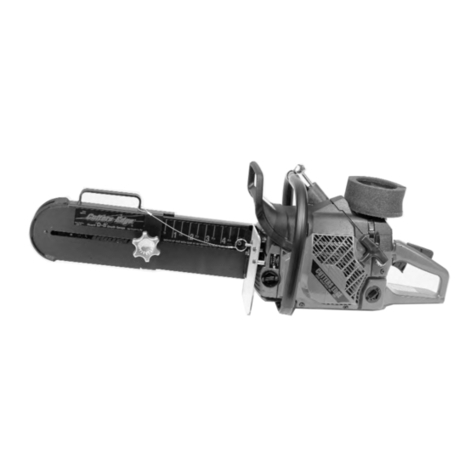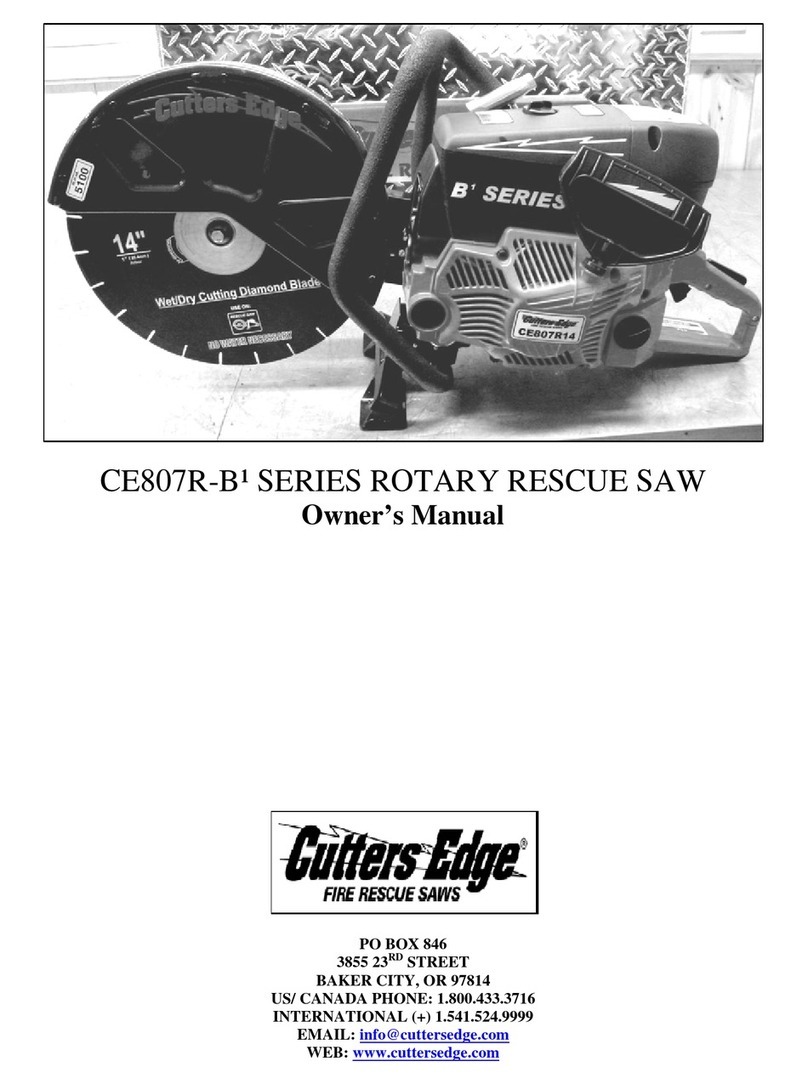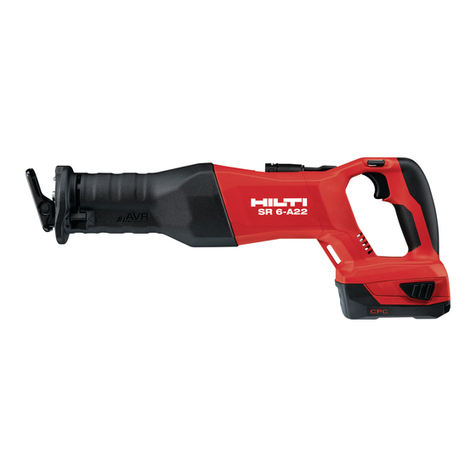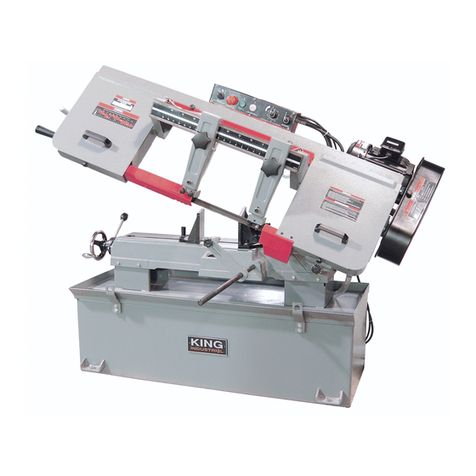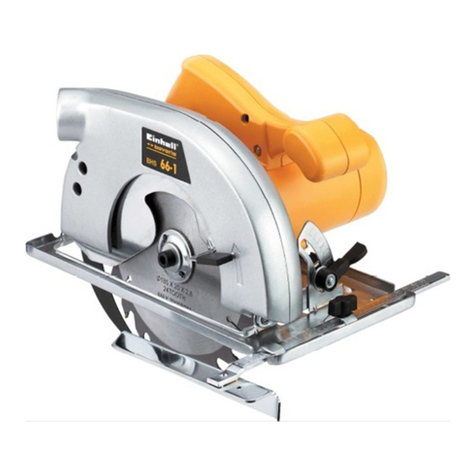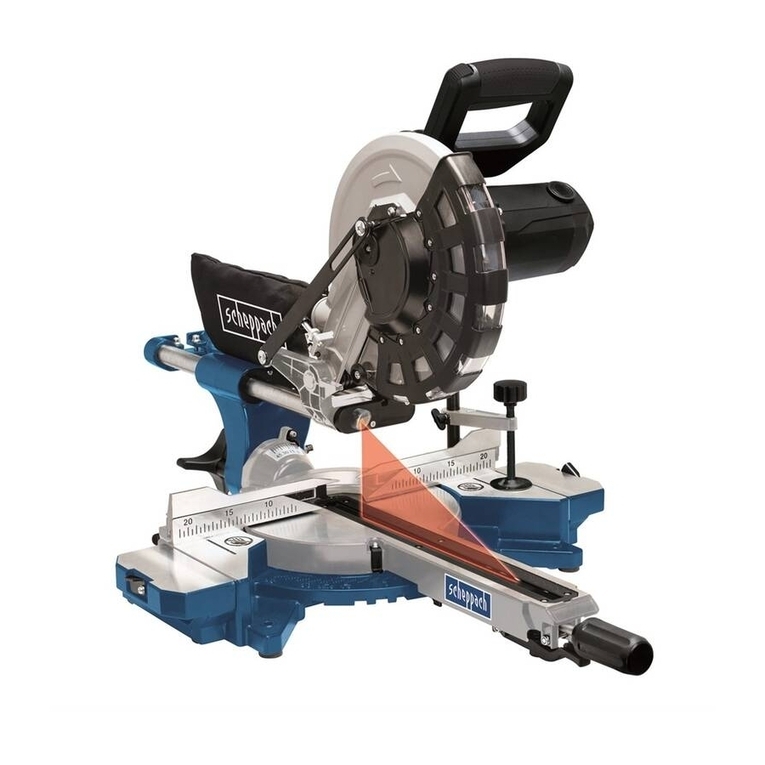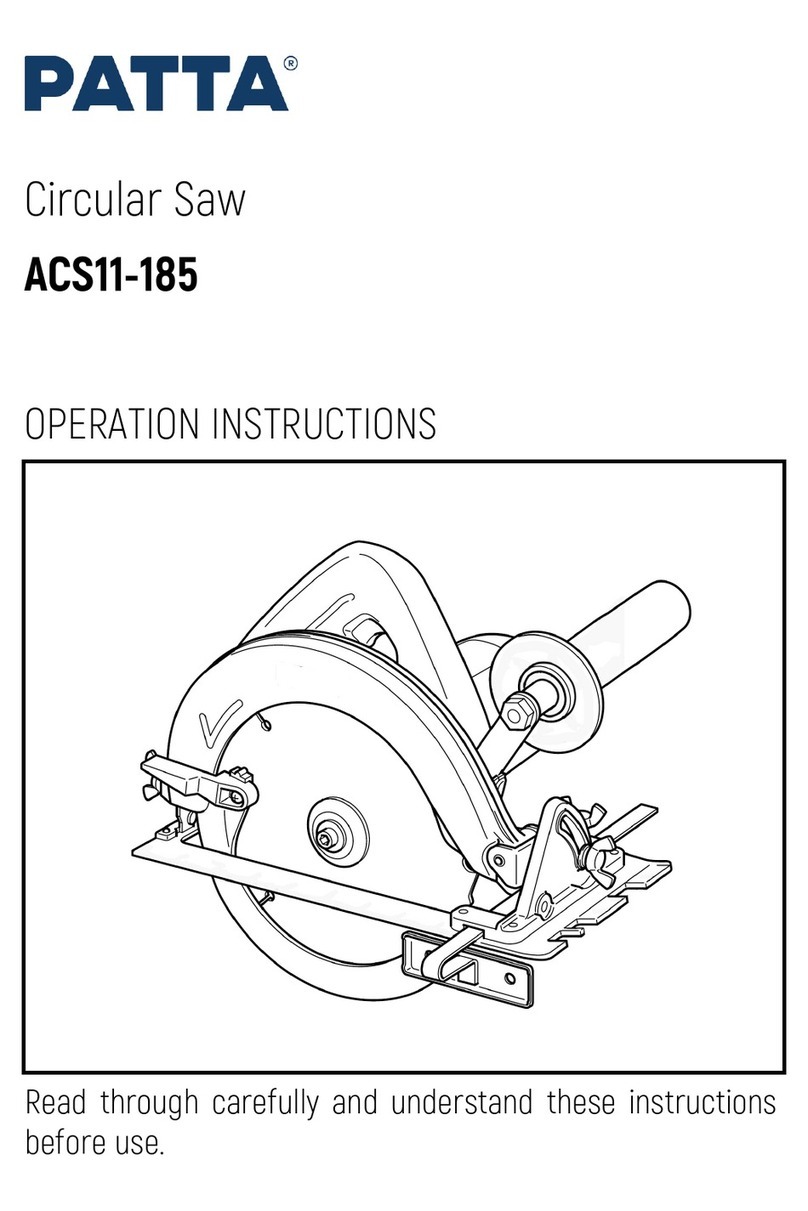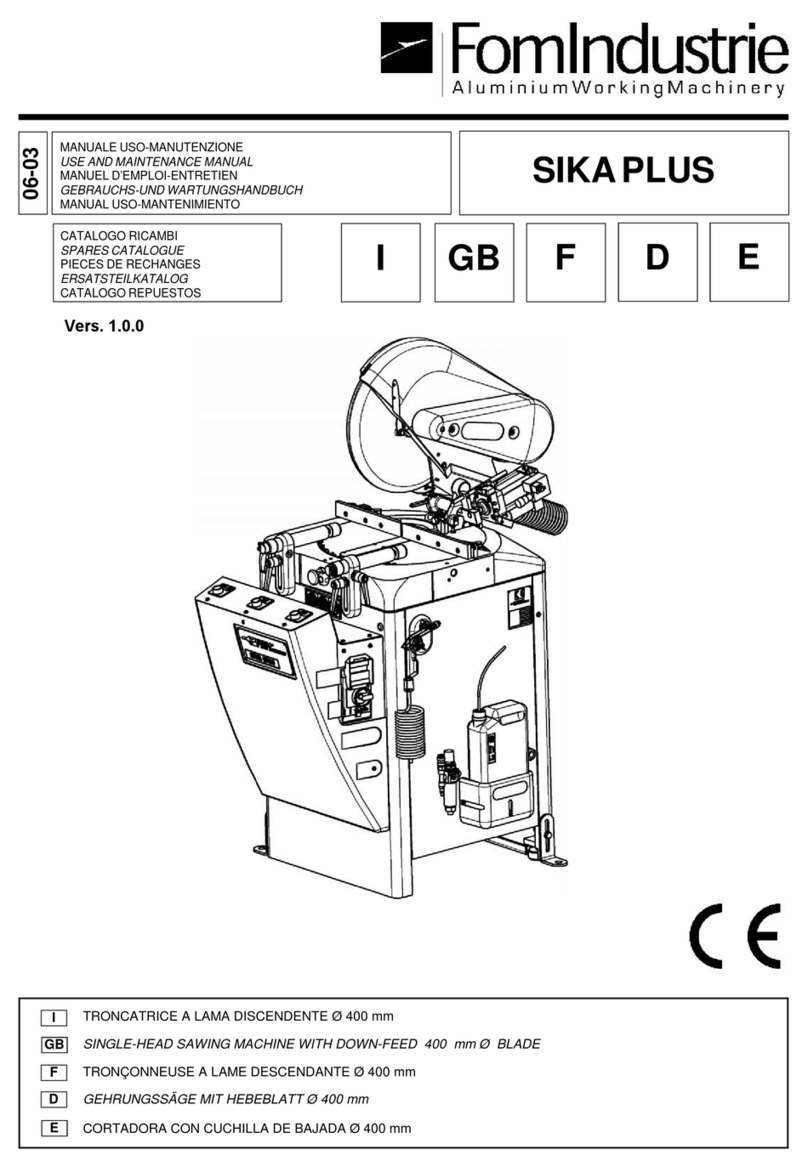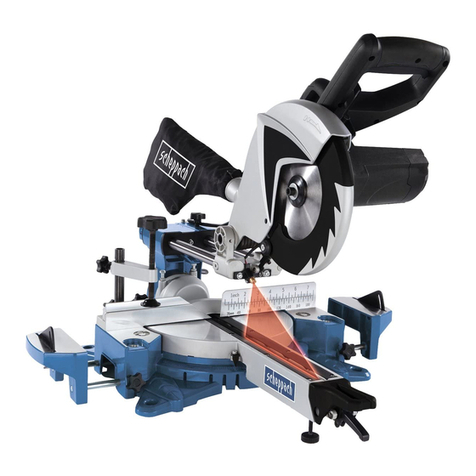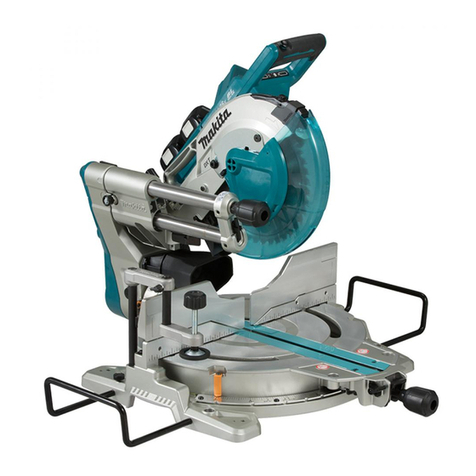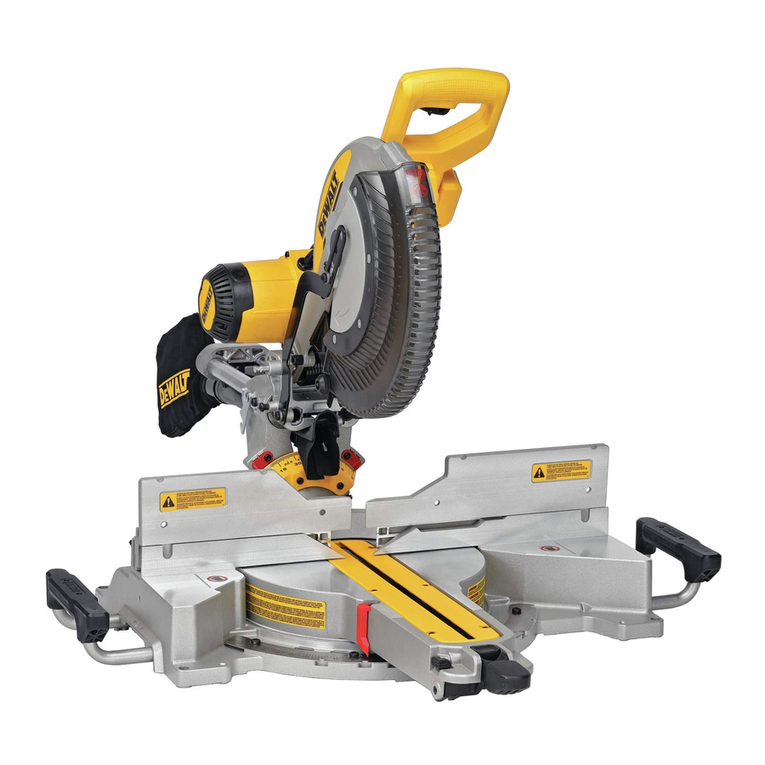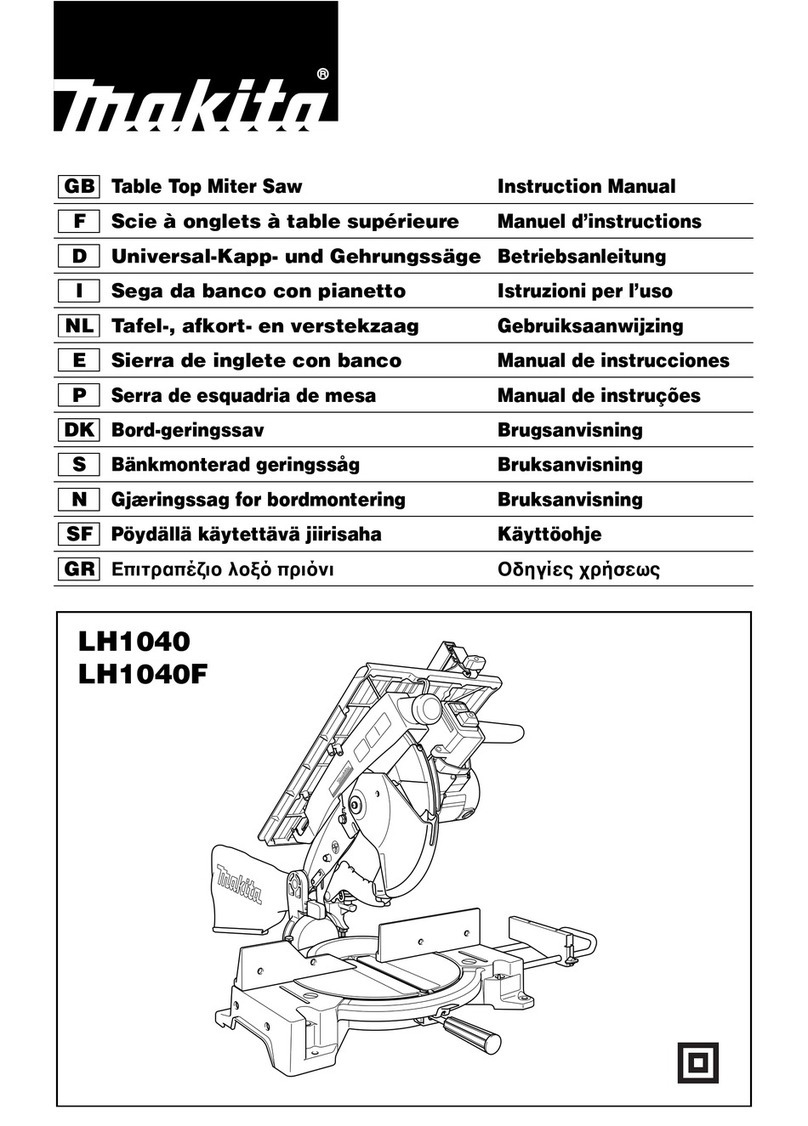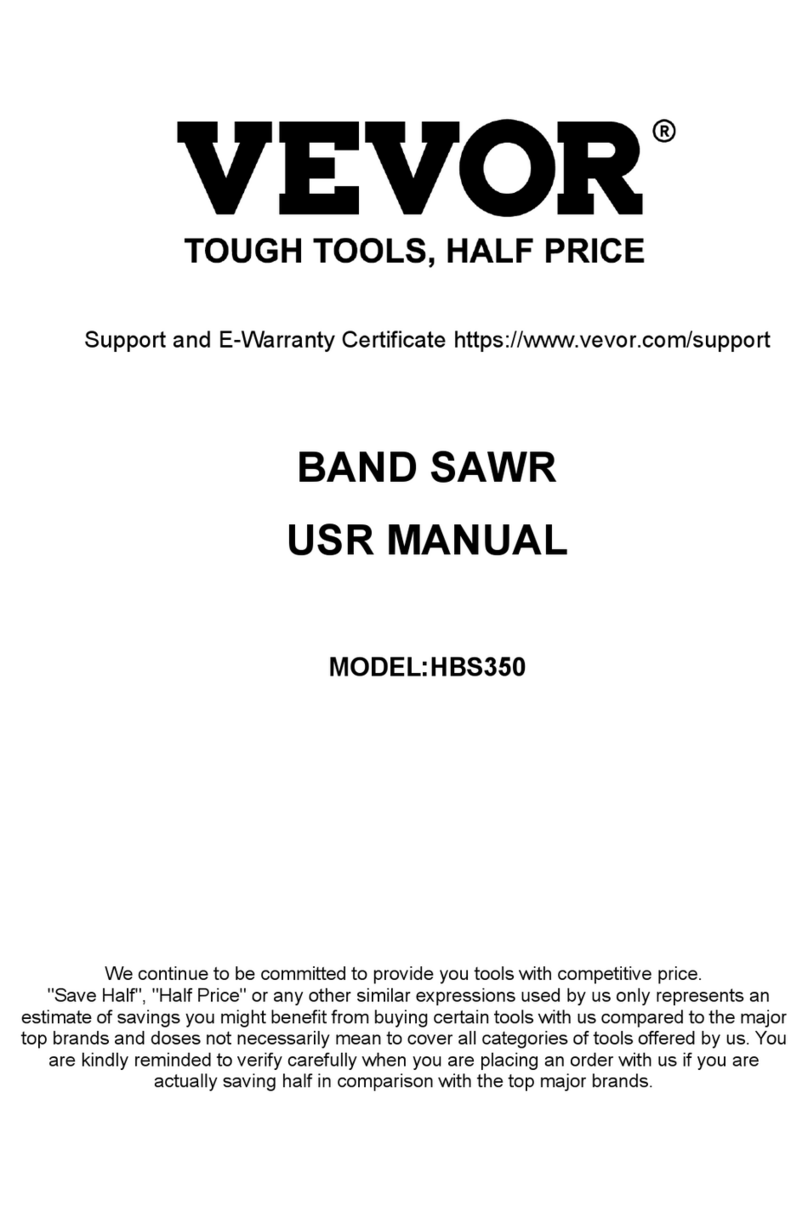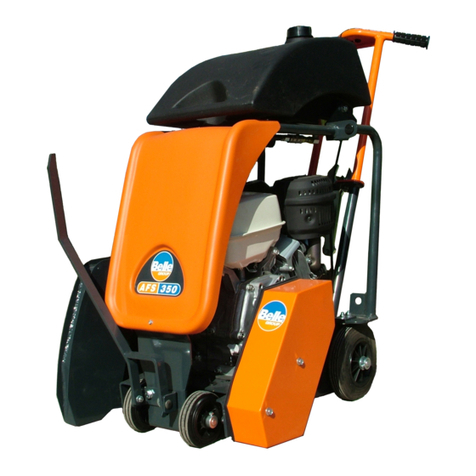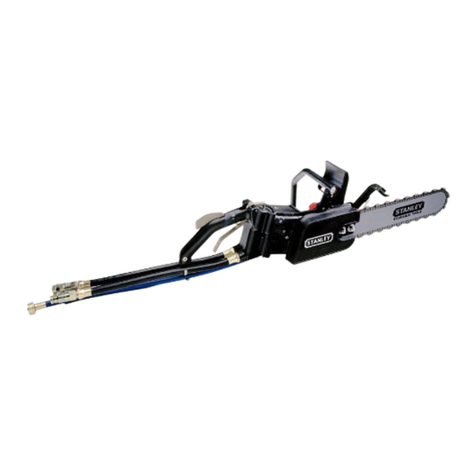Cutters Edge CE-770RH SERIES User manual

OPERATOR’S MANUAL
MODELS #CE-770RH / CE-970RH / CE-1270RH SERIES
EAST COAST SERVICE CENTER
Eastern Fire Equipment Services
440 Oak Street
Lemoyne, PA 17043
U.S. Phone - 717.412.7746
CUTTERS EDGE
Cutters Edge, Division of Edge Industries, Inc.
3855 23rd Street
P.O. Box 846
Baker City, OR 97814
U.S./Canada - 1.800.433.3716
International - (+) 1.541.524.9999
Web - cuttersedge.com
October 2018
Q:\ Good Documents \ Manuals & Products \ CE760/970/1260_Op_Manual IPL
Please read the operator’s manual carefully and make sure you understand the
instructions fully before using the machine. It is the owner’s responsibility to make
sure that any person who uses this power cutter has read this manual!

CUTTERS EDGE
1
770/970/1270 Model
Edge Industries, Inc., USA
Key To Symbols

CUTTERS EDGE
2
770/970/1270 Model
Contents
CE-770-RH, CE-970-RH and CE-1270-RH
Operations Manual
Keys to Symbols .................................................................. 1
Contents ............................................................................... 2
Overview / Features ............................................................. 3
Part Locations - Model CE770 ....................................... 4
Part Locations - Model CE970 ............................................. 5
Part Locations - Model CE1270 ..................................... 6
General Safety ...................................................................... 7
Safety Equipment ................................................................ 8
Cutting Blades ..................................................................... 9 - 10
Assembling & Adjustments ............................................... 11
Fuel Handling ...................................................................... 12-13
Operating ...................................................................... 14 -18
Starting & Stopping ....................................................... 19-22
General Maintenance ................................................... 23
Cleaning & Inspection .................................................... 24- 27
Maintenance - Starter .................................................... 28
Maintenance - Air Filter - CE770 .................................... 29
Maintenance - Air Filter - CE970 / CE1270 ..................... 30
Technical Data - CE770 / CE970 ................................... 31
Technical Data - CE1270 ................................................32
Federal Emissions & Warranty ...................................... 33

z
CUTTERS EDGE
3
770/970/1270 Model
Cutters Edge product.
Cutters Edge / Husqvarna products.
Cutters Edge
cuttersedge.com
K&N Air Filters
Waterproof with up to 60% more air flow.
Reflective Labels
Makes it easier to see the saw in dark, smokey conditions.
Illuminating Handle (Optional)
Glows in the dark.
Full Wrap Handle (Optional)
Better control in any cutting position.

CUTTERS EDGE
4
770 Model
Part Locations
1
1 Front handle
2 Water valve
3 Warning decal
4 Air filter cover
5 Cylinder cover
6 Choke control with start throttle lock
7 Throttle trigger lockout
8 Throttle trigger
9 Stop switch
10 Disconnection function for OilGuard
11 Starter handle
12 Starter housing
13 Muffler
14 Cutting equipment decal
15 Flange, spindle, bushing
16 Adjustment handle for guard
17 Blade guard
18 Decompression valve
19 Air purge
20 Fuel cap
21 Water connection with filter
22 Belt guard
23 Belt tensioner
24 Type plate
25 Cutting arm
26 Cutting head
27 Cutting blade
28 Combination wrench
29 Water connector
30 Operator’s manual
Whats on the CE-770 RH Series Rotary Saw
5
6
7
8
9
10
11
12
13
14
15
16
17
18
19
20
21
22 23 24 25
26
27
28
29
30

CUTTERS EDGE
5
970 Model
Parts Location
What is what on the CE-970 RH Series Rotary Saw?
1 Front handle
2 Water tap
3 Warning decal
4 Air filter cover
5 Cylinder cover
6 Choke control with start throttle lock
7 Throttle trigger lockout
8 Throttle trigger
9 Air purge
10 Stop switch
11 Starter handle
12 Starter housing
13 Decompression valve
14 Muffler
15 Adjustment handle for guard
16 Blade guard
17 Fuel cap
18 Type plate
19 Water connection with filter
20 Belt guard
21 Cutting arm
22 Belt tensioner
23 Cutting head
24 Cutting blade
25 Combination Wrench
26 Water connector
27 Operator’s manual
28 Cutting equipment decal

CUTTERS EDGE
6
1270 Model
Part Locations
1 Front handle
2 Water tap
3 Information and warning decal
4 Air filter cover
5 Cylinder cover
6 Choke control
7 Start throttle lock
8 Stop switch
9 Fuel tank
10 Starter
11 Starter handle
12 Rating plate
13 Decompression valve
What is what on the CE-1270 RH Series Rotary Saw?
14 Adjustment handle for guard
15 Guard for the blade
16
Cutting blade
17 Cutting arm
18 Belt tensioner
19 Muffler
20 Cutting head
21 Water connector
22 Throttle control
23 Throttle lockout
24 Combination Wrench
25 Operator′s manual

CUTTERS EDGE
7
770/970/1270 Model
General Safety
When released, the switch
should return to the “on”
position.
This section describes the machine′s safety equipment, its
purpose, and how checks and maintenance should be
carried out to ensure that it operates correctly.
Throttle trigger lockout
The throttle trigger lock is designed to prevent accidental
operation of the throttle. When the lock (A) is pressed in
this releases the throttle (B).
The trigger lock remains pressed in as long as the throttle is
pressed. When the grip on the handle is released the
throttle trigger and the throttle trigger lock both return to
their original positions. This is controlled by two
independent return spring systems. This means that the
throttle trigger is automatically locked in the idle position.
Checking the throttle lockout
•Make sure that the throttle trigger is locked at idle
setting when the throttle trigger lockout is released.
• Press the throttle lockout and make sure it returns to its
original position when you release it.
• Check that the throttle trigger and throttle lockout move
freely and that the return springs work properly.
• Start the power cutter and apply full throttle. Release the
throttle control and check that the cutting blade stops and
remains stationary. If the cutting blade rotates when the
throttle is in the idle position you should check the
carburettor’s idle adjustment. See instructions in the
section "Maintenance".
Stop switch
Use the stop switch to switch off the engine.
Checking the stop switch
•Start the engine and make sure the engine stops when
you move the stop switch to the stop setting.
!
WARNING! Never use a machine that has
faulty safety equipment! If your machine
fails any checks contact your service
agent to get it repaired.
The engine should be switched off, and
the stop switch in STOP position.
Blade guard
This guard is fitted above the cutting blade and is
designed to prevent parts of the blade or cutting
fragments from being thrown towards the user.
Checking the blade and the blade guard
•Check that the guard over the cutting
blade is not cracked or damaged in any
other way. Replace when damaged.
•Check that the cutting blade is fitted
correctly and does not show signs of
damage. A damaged cutting blade can
cause personal injury.
!
WARNING! Always check that the guard
is correctly fitted before starting the
machine.

CUTTERS EDGE
8
770/970/1270 Model
Safety Equipment
Vibration damping system
•Your machine is equipped with a vibration damping system
that is designed to reduce vibration and make operation
easier.
•The machine′s vibration damping system reduces the transfer
of vibration between the engine unit/cutting equipment and
the machine′s handle unit. The engine body, including the
cutting equipment, is insulated from the handles by vibration
damping units.
!
WARNING! Overexposure to vibration can
lead to circulatory damage or nerve damage
in people who have impaired circulation.
Contact your doctor if you experience
symptoms of overexposure to vibration. Such
symptoms include numbness, loss of feeling,
tingling, pricking, pain, loss of strength,
changes in skin colour or condition. These
symptoms normally appear in the fingers,
hands or wrists. These symptoms may be
increased in cold temperatures.
Muffler
The muffler is designed t o keep noise levels to a minimum and
to direct exhaust fumes away from the user.
Inspecting the muffler
Check regularly that the muffler is complete and secured
correctly.
!
WARNING! Never use a machine without a
muffler, or with a faulty muffler. A damaged
muffler may substantially increase the noise
level and the fire hazard. Keep fire fighting
equipment handy.
The muffler gets very hot during and after use
as well as when idling. Be aware of the fire
hazard, especially when working near
flammable substances and/or vapors.
Keep fire fighting equipment handy.

CUTTERS EDGE
9
Cutting Blades
770/970/1270 Model
General
•Cutting blades are available in two basic designs;
abrasive blades and diamond blades.
• High-quality blades are often most economical. Lower quality
blades often have inferior cutting capacity and a shorter service
life, which results in a higher cost in relation to the quantity of
material that is cut.
• Make sure that the right bushing is use d for the cutting blade to
be fitted on the machine. See the inst ructions under the heading
Fitting the cutting blade.
Suitable cutting blades
*Without water
Cutting blades for different materials
Follow the instructions supplied with the cutting blade
concerning the suitability of the blade for various applications, or
consult your dealer in case of doubts.
Cutting blades H Series
Abrasive blades Yes*
Diamond blades Yes
!
WARNING! Never use a cutting blade
for any other materials than what it
was intended to cut.
Never use a diamond blade to cut
plastic material. The heat produced
during cutting may melt the plastic
and it can stick to the cutting blade
and cause a kickback.
Concrete Metal Plastic Cast
iron
Abrasive
blades X X X X
Diamond
blades XX* X*
!
WARNING! A cutting blade may
burst and cause injury to the
operator.
* Only specialty blades.
Hand held, high speed machines
•Many cutting blades t hat might fit this power cutter
are intended for stationary saws and have a lower
speed rating than is needed for this hand-held saw.
Cutting blades with a lower speed rating shall never
be used on this saw.
•Our cutting blades our manufactured for high-speed
portable power cutters.
•Check that the blade is approved for the same or
higher speed according to the approval plate of the
engine. Never use a cutting blade with a lower speed
rating than that of the power cutter.
!
WARNING! Never use a cutting
blade with a lower speed rating
than that of the power cutter.
Blade vibration
•The blade can become out-of-round and vibrate if an
excessive feed pressure is used.
• A lower feed pressure can stop the vibration.
Otherwise replace the blade.
If you use Abrasive Blades
•The cutting material on abrasive blades consists of
grit bonded using an organic binder. ”Reinforced
blades” are made up of a fabric or fibre base that
prevents total breakage at maximum working speed if
the blade should be cracked or damaged.
• A cutting blade’s performance is determined by the
type and size of abrasive corn, and the type and
hardness of the bonding agent.
• Ensure the cutting blade is not cracked or damaged.
• Test the abrasive blade by hanging it on your finger
and tapping it lightly with a screwdriver or the like. If
the blade does not produce a resonant, ringing sound
it is damaged.

CUTTERS EDGE
10
770/970/1270 Model
Cutting Blades
Abrasive blades for different materials
Blade type Material
Concrete blade
Concrete, asphalt, stone masonry,
cast iron, aluminium, copper, brass,
cables, rubber, plastic, etc.
Metal blade Steel, steel alloys and other hard
metals.
!
WARNING! Do not use abrasive blades
with water. The strength is impaired
when abrasive blades are exposed to
water or moisture, which results in an
increased risk of the blade breaking.
Diamond blades
General
!
WARNING! Never use a diamond blade
to cut plastic material. The heat
produced during cutting may melt the
plastic and it can stick to the cutting
blade and cause a kickback.
Diamond blades become very hot when
used. An overheated blade is a result of
improper use, and may cause
deformation of the blade, resulting in
damage and injuries.
•Diamond blades consist of a steel core provided with
segments that contain industrial diamonds.
•Diamond blades ensure lower costs per cutting
operation, fewer blade changes and a constant cutting
depth.
•When using diamond blades make sure that it rotates
in the direction indicated by the arrow on the blade.
Diamond blades for different materials
•Diamond blades are ideal for masonry, reinforced
concrete and other composite materials.
•Diamond blades are available in several
hardness classes.
•Special blades should be used when cutting
metal. Ask your dealer for help in choosing the
right product
•Cutters Edge brand diamond blades can be used
to cut all materials and can be used in dry or wet
cutting situations..
De-glazing diamond blades
•Always use a sharp diamond blade.
•Diamond blades can become dull or glazed when the wrong
feeding pressure is used or when cutting certain materials such
as heavily reinforced concrete. Working with a dull diamond
blade causes overheating, which can result in the diamond
segments coming loose.
•De-glaze the blade by cutting in a soft material such as
sandstone or brick.
Diamond blades for dry cutting
•Although no water is required for cooling, dry cutting blades
must be cooled with air flow around the blades. For this
reason dry cutting blades are recommended only for
intermittent cutting. Every few seconds of cutting the blade
should be allowed to run 'free” with no load to allow the air flow
around the blade to dissipate the heat.
Diamond blades for wet cutting
•Wet cutting diamond blades must be used with water to keep
the blade core and segments cool during sawing.
•Wet cutting blades should NOT be used dry.
•Using wet cutting blades without water can cause excessive
heat build-up, resulting in poor performance, severe blade
damage and is a safety hazard.
•Water cools the blade and increases its service life while also
reducing the formation of dust.
Transport and storage (If using abrasive blade)
•Do not store or transport the power
cutter with the cutting blade fitted. All
blades should be removed from the
cutter after use and stored carefully.
•Store cutting blades in dry, frost free
conditions. Special care should be taken
with abrasive blades. Abrasive blades
must be stored on a flat, level surface. If
an abrasive blades is stored in humid
conditions, this can cause imbalance
and result in injury.
•Inspect new blades for transport or
storage damage.

CUTTERS EDGE
11
Assembling & Adjustments 770/970/1270 Model
Checking the drive shaft and
flange washers
When the blade is replaced with a new one, check the flange
washers and the spindle shaft.
• Check that the threads on the spindle shaft are undamaged.
• Check that the contact surfaces on the blade and the flange
washers are undamaged, of the correct dimension, clean,
and that they run properly on the spindle shaft.
!
WARNING! The engine should be
switched off
Do not use warped, notched, indented or dirty flange washers.
Do not use different dimensions of flange washers.
Fitting the cutting blade
•The blade is placed on the bushing (A) between the inner
flange washer (B) and the flange washer (C). The flange
washer is turned so that it fits on the axle.
• Lock the shaft. Insert a tool in t he hole in the cutting head
and rotate the blade until it is locked.
• Tightening torque for the bolt holding the blade is: 25 Nm
(215 in.lb).
Blade guard
The guard for the cutting equipment should be adjusted so
that the rear section is flush with the work piece. Spatter and
sparks from the material being cut are then collected up by
the guard and led away from the user.
The blade guard is friction locked.
• Press the ends of the guard against the work piece or
adjust the guard with the adjustment handle. The guard
must always be fitted on the machine.

CUTTERS EDGE
12
770/970/1270 Model
Fuel Handling
!
WARNING! Running an engine in a confined or
badly ventilated area can result in death due to
asphyxiation or carbon monoxide poisoning.
Use fans to ensure proper air circulation when
working in trenches or ditches deeper than one
meter (3 foot).
Fuel and fuel fumes are flammable and can
cause serious injury when inhaled or allowed to
come in contact with the skin. For this reason
observe caution when handling fuel and make
sure there is adequate ventilation.
The exhaust fumes from the engine are hot
and may contain sparks which can start a fire.
Never start the machine indoors or near
combustible material!
Do not smoke and do not place any hot objects
in the vicinity of fuel.
Fuel
Gasoline
•Use good quality unleaded gasoline.
•The lowest recommended octane grade is 87
((RON+MON)/2). If you run the engine on a
lower octane grade than 87 so-called knocking
can occur. This gives rise to a high engine
temperature and increased bearing load, which
can result in serious engine damage.
•When working at continuous high revs a higher
octane rating is recommended.
NOTICE! The machine is equipped with a two-stroke engine
and must always be run using a mixture of gasoline and
two-stroke engine oil. It is important to accurately measure
the amount of oil to be mixed to ensure that the correct
mixture is obtained. When mixing small amounts of fuel,
even small inaccuracies can drastically affect the ratio of
the mixture.
Two-stroke oil
•For best results and performance use Cutters Edge two-
stroke engine oil, which is specially formulated for our air-
cooled two stroke-engines.
•Never use two-stroke oil intended for water-cooled
engines, sometimes referred to as outboard oil (rated TCW).
•Never use oil intended for four-stroke engines.
K 770 OilGuard
•Use HUSQVARNA OilGuard two stroke oil.
Mixing
•Always mix the gasoline and oil in a clean container
intended for fuel.
•Always start by filling half the amount of the gasoline to
be used. Then add the entire amount of oil. Mix
(shake) the fuel mixture. Add the remaining amount of
gasoline.
•Mix (shake) the fuel mixture thoroughly before filling the
machine’s fuel tank.
•Do not mix more than one month’s supply of fuel at a
time.
Mixing ratio
100:1 for Cutters Edge synthetic oil. 50:1 for petroleum
based oils. For other brand synthetic oils, follow the
manufacturer’s instructions for mix ratio.

CUTTERS EDGE
13
770/970/1270 Model
Fuel Handling
Fueling
Never start the machine:
• If you have spilled fuel or engine oil on the machine,
wipe off the spillage and allow remaining fuel to
evaporate.
• If you have spilled fuel on yourself or your clothes,
change your clothes. Wash any part of your body that
has come in contact with fuel. Use soap and water.
• If the machine is leaking fuel. Check regularly for
leaks from the fuel cap and fuel lines.
• Unless the fuel cap is securely tightened after
refueling.
Transport and storage
•Store and transport the mach ine and fuel so that
there is no risk of any leakage or fumes coming into
contact with sparks or open flames, for example, from
electrical machinery, electric motors, electrical relays/
switches or boilers.
•When storing and transporting fuel always use
approved containers intended for this purpose.
Long-term storage
•When storing the machine for long periods the fuel tank must be
emptied. Contact your local gas station to find out where to dispose
of excess fuel.
!
WARNING! Taking the following
precautions, will lessen the risk of fire:
Do not smoke and do not place any hot
objects in the vicinity of fuel.
Always stop the engine and let it cool for
a few minutes before refueling. The
engine should be switched off, and the
stop switch in STOP position.
When refuelling, open the fuel cap slowly
so that any excess pressure is released
gently.
Clean the area around the fuel cap.
Tighten the fuel cap carefully after
refueling.
If the cap is not properly tightened the
cap might vibrate lose and fuel may
escape from the fuel tank creating a fire
hazard.
Move the machine at least 10 ft (3 m)
from the refuelling point before starting
it.

CUTTERS EDGE
14
770/970/1270 Model
Operating
Protective equipment
General
•Do not use the machine unless you are able to call for
help in the event of an accident.
Personal protective equipment
You must use approved personal protective equipment
whenever you use the machine. Personal protective
equipment cannot eliminate the risk of injury but it will
reduce the degree of injury if an accident does happen.
Ask your dealer for help in choosing the right equipment.
!
WARNING! The use of products such as
cutters, grinders, drills, that sand or form
material can generate dust and vapors
which may contain hazardous chemicals.
Check the nature of the material you
intend to process and use an appropriate
breathing mask.
Long-term exposure to noise can result in
permanent hearing impairment. Always
use approved hearing protection. Listen
for warning signals or shouts when you
are wearing hearing protection. Always
remove your hearing protection as soon
as the engine stops.
Always wear:
• Approved protective helmet
• Hearing protection
•Eye protection.
•Respiratory protection
• Heavy-duty, firm grip gloves.
• Tight-fitting, heavy-duty and comf ortable
clothing that permits full freedom of
movement.
• Boots with steel toe-caps and non-slip sole
Other protective equipment
•Fire Extinguisher
•Always have a first aid kit nearby.
!
CAUTION! Sparks may appear and start a fire
when you work with the machine. Always keep
fire fighting equipment handy.
General safety precautions
This section describes basic safety directions
for using the machine. This information is never
a substitute for professional skills and
experience.
• Please read the operator’s manual carefully
and make sure you understand the
instructions before using the machine. It is
recommended that first time operators also
obtain practical instruction before using the
machine.
• Keep in mind that it is you, the operator that is
responsible for not exposing people or their
property to accidents or hazards.
• The machine must be kept clean. Signs and
stickers must be fully legible.
Always use common sense
It is not possible to cover every conceivable situation you can face. Always
exercise care and use your common sense. If you get into a situation where you
feel unsafe, stop and seek expert advice. Contact your dealer, service agent or an
experienced user. Do not attempt any task that you feel unsure of!
!
WARNING! The machine can be a dangerous tool if used
incorrectly or carelessly, which can cause serious or
fatal injury to the operator or others.
Never allow children or other persons not trained in the
use of the machine to use or service it.
Never allow anyone else to use the machine without first
ensuring that they have read and understood the contents
of the operator’s manual.
Never use the machine if you are fatigued, while under the
influence of alcohol or drugs, medication or anything that
could affect your vision, alertness, coordination or
judgement.
!
WARNING! Unauthorized modifications and/or
accessories may lead to serious injury or death to the
user or others. Under no circumstances may the design of
the machine be modified without the permission of the
manufacturer.
Do not modify this product or use it if it appears to have
been modified by others.
Never use a machine that is faulty. Carry out the safety
checks, maintenance and service instructions described
in this manual. Some maintenance and service measures
must be carried out by trained and qualified specialists.
See instructions under the heading Maintenance.
Always use genuine accessories.
Your warranty may not cover damage or liability caused
by the use of non-authorized accessories or replacement
parts.
WARNING! This machine produces an electromagnetic
field during operation. This field may under some
circumstances interfere with active or passive medical
implants. To reduce the risk of serious or fatal injury, we
recommend persons with medical implants consult their
physician and the medical implant manufacturer before
operating this machine.

CUTTERS EDGE
15
770/970/1270 Model
Operating
Work area safety
•Observe your surroundings to ensure that nothing
can affect your control of the machine.
•Ensure that no one/nothing can come into contact
with the cutting equipment or be hit by parts thrown
by the blade.
•Do not use the machine in bad weather, such as
dense fog, heavy rain, strong wind, intense cold, etc.
Working in bad weather is tiring and can lead to
dangerous conditions, e.g. slippery surfaces.
•Never start to work with the machine before the
working area is clear and you have a firm foothold.
Look out for any obstacles with unexpected
movement. Ensure when cutting that no material can
!
WARNING! The safety dista nce for the
power cutter is 50 feet (15 metres). You
are responsible to ensure that animals
and onlookers are not within the
working area. Do not start cutting until
the working area is clear and you are
standing firmly.
become loose and fall, causing injury to the
operator.Take great care when working on
sloping ground.
• Ensure that the working area is sufficiently
illuminated to create a safe working environment.
• Make sure that no pipes or electrical cables are
routed in the working area or in the material to be
cut.
• If cutting into a container (drum, pipe, or other
container) you must first makee sure it does not
contain flammable or other volatile material.
Basic working techniques
•The machine is designed and intended for cutting with
abrasive blades or diamond blades intended for high
speed handheld machines. The machine shall not be used
with any other type of blade, or for any other type of cutting.
•Check that the cutting blade is fitted correctly and does
not show signs of damage. See the instructions in the
sections "Cutting blades" and "Assembly and
adjustments".
•Check that the correct cutting blade is used for the
application in question. See instructions in the section
"Cutting blades".
•Never cut asbestos materials!
!
WARNING! Do not pull the power cutter to
one side, this can cause the blade to jam or
break resulting in injury to people.
Under all circumstances avoid grinding
using the side of the blade; it will almost
certainly be damaged or break and can
cause immense damage. Only use the
cutting section.
Before entering an existing slot made by
another blade, check that the slot is not
thinner than your blade as that may result in
binding in the cutting slot and a kickback.
Never use a diamond blade to cut plastic
material. The heat produced during cutting
may melt the plastic and it can stick to the
cutting blade and cause a kickback.
Cutting metal generates sparks that may
cause fire. Do not use the machine near
ignitable substances or gases.
!!

CUTTERS EDGE
770/970/1270 Model
Operating
•Hold the saw with both hands; keep a firm grip with
thumbs and fingers encircling the handles. The
right hand should be on the rear handle and the
left hand on the front handle. All operators,
weather right or left handed shall use this grip.
Never operate a power cutter holding it with only
one hand.
• Stand parallel to the cutting blade. Avoid standing
straight behind. In the event of a kickback the saw
will move in the plane of the cutting blade.
• Maintain a safe distance from the cutting blade
when the engine is running.
• Never leave the machine unsupervised with the
motor running.
• Never move the machine when the cutting
equipment is rotating. Make sure that the blade
has come to a complete stop before the machine
is put on the ground. The machine is equipped with
a friction retarder to shorten the blade stop time.
• The guard for the cutting equipment should be
adjusted so that the rear section is flush with the
work piece. Spatter and sparks from the material
being cut are then collected up by the guard and
led away from the user. The guards for the cutting
equipment must always be fitted when the
machine is running.
• Never use the kickback zone of the blade for
cutting. See instructions under the heading
"Kickback".
• Keep a good balance and a firm foothold.
• Never cut above shoulder height.
• Never cut from a ladder. Use a platform or scaffold
if the cut is above shoulder height. Do not
overreach
• Move the blade slowly forwards and backwards to
achieve a small contact area between the blade
and the material to be cut. This reduces the
temperature of the blade and ensures effective
cutting.
Managing dust
The machine is fitted with a low flushing water kit that
offers maximum dust suppression.
Use wet cutting blades with water cooling when
possible for optimal dust management. See
instructions in the section "Cutting blades".
Adjust the water flow using the valve to bind the
cutting dust. The volume of water required varies
depending on the type of job at hand.
If water hoses loosen from their supply sources, this
indicates that the machine is connected to a water
pressure that is too high. See instructions under the
"Technical data" heading for recommended water
pressure.
• Stand at a comfortable distance from the work
piece.
• Check that the blade is not in contact with
anything when the machine is started
• Apply the cutting blade gently with high rotating
speed (full throttle) Maintain full speed until cutting
is complete.
• Let the machine work without forcing or pressing
the blade.
• Feed down the machine in line with the blade.
Pressure from the side can damage the blade and
is very dangerous.
16

CUTTERS EDGE
770/970/1270 Model
Operating
Climbing kickback
If the kickback zone is used for cutting the reactive force
drives the blade to climb up in the cut. Do not use the
Kickback
Kickback is the sudden upward motion that can occur if the
blade is pinched or stalled in the kickback zone. Most
kickbacks are small and pose little danger. However a
kickback can also be very violent and throw the power cutter
up and back towards the user in a rotating motion causing
serious or even fatal injury.
Reactive force
A reactive force is always present when cutting.T he force
pulls the machine in the opposite direction to the blade
rotation. Most of the time this force is insignificant. If the blade
is pinched or stalled the reactive forc e will be strong and you
might not be able to control the power cutter.
Never move the machine when the cutting equipment is
rotating. Gyroscopic forces can obstruct the intended
movement.
Kickback zone
Never use the kickback zone of the blade for cutting.If the
blade is pinched or stalled in the kickback zone, the reactive
force will push the power cutter up and back towards the user
in a rotating motion causing serious or even fatal injury.
kickback zone. Use the lower quadrant of the blade to avoid
climbing kickback.
Pinching kickback
Pinching is when the cut closes and pinches the blade. If the
blade is pinched or stalled the reactive force will be strong and
you might not be able to control the power cutter.
If the blade is pinched or stalled in the kickback zone, the
reactive force will push the power cutter up and back towards
the user in a rotating motion causing serious or even fatal
injury. Be alert for potential movement of the work piece. If the
work piece is not properly supported and shifts as you cut, it
might pinch the blade and cause a kick back.
Pipe cutting
Special care should be taken when cutting in pipes. If the pipe
is not properly supported and the cut kept open through out
the cutting, the blade might be pinched in the kickback zone
and cause a severe kickback. Be especially alert when cutting
a pipe with a belled end or a pipe in a trench that, if not
properly supported, may sag and pinch the blade.
Before starting the cut the pipe must be secure so it does not
move or roll during cutting.
If the pipe is allowed to sag and close the cut, the blade will be
pinched in the kick back zone and a severe kick back might
develop. If the pipe is properly supported the
!
WARNING! Kickbacks are sudden and can be
very violent. The power cutter can be thrown
up and back towards the user in a rotating
motion causing serious or even fatal injury. It
is vital to understand what causes kickback
and how to avoid it before using the machine.
17

CUTTERS EDGE
770/970/1270 Model
end of the pipe will move downward, the cut will open and
no pinching will occur.
Proper sequence cutting a pipe
1 First cut section I.
2 Move to side II and cut from section I to bottom of the
pipe.
3 Move to side III and cut the remaining part of the pipe
ending at the bottom.
How to aviod kickback
Avoiding kickback is
simple.
• The work piece must always be supported so that the
cut stays open when cutting through. When the cut
opens there is no kickback. If the cut closes and
pinches the blade there is always a risk of kickback.
•Take care when inserting the blade in an existing cut.
• Be alert to movement of the work piece or anything
else that can occur, which could cause the cut to close
and pinch the blade.
Transport and storage
•Secure the equipment during transportation in order
to avoid transport damage and accidents.
•Do not store or transport the power cutter with the
cutting blade fitted.
•For transport and storage of cutting blades, see the
section "Cutting blades".
•For transport and storage of fuel, see the section
"Fuel handling".
•Store the equipment in a lockable area so that it is out
of reach of children and unauthorized persons.
I
III II
Operating
18

CUTTERS EDGE
770/970/1270 Model
Starting & Stopping
Before starting
•Perform daily maintenance. See instructions in the section
"Maintenance".
Starting
With a cold engine:
• Start throttle position and choke is obtained by pulling out the
choke control completely.
•Decompression valve: Press in the valve to reduce the
pressure in the cylinder, this is to assist starting the power
cutter. The decompression valve should always be used
when starting. The valve automatically returns to its initial
position when the machine starts.
• Press the air purge diaphragm repeatedly until fuel begins
to fill the diaphragm (about 6 times). The diaphragm need
not be completely filled.
• Grip the front handle with your left hand. Put your right foot on
the lower section of the rear handle pressing the machine
against the ground. Pull the starter handle with your right
hand until the engine starts. Never wrap the starter cord
around your hand
•Push in the choke control as soon as the engine starts, with
the choke pulled out the engine will stop after a few
seconds. (If the engine stops anyway, pull the starter handle
again.)
•Press the throttle trigger to disengage the start throttle and the
machine will idle.
!
WARNING! Note the following before starting:
Please read the operator’s manual carefully
and make sure you understand the
instructions before using the machine.
Wear personal protective equipment. See
under heading ”Personal protective
equipment”.
Do not start the machine without the belt and
belt guard fitted. Otherwise the clutch could
come loose and cause personal injuries.
Check that the fuel cap is properly
secured, and that there is no fuel
leakage.
Make sure no unauthorised persons are in
the working area, otherwise there is a risk of
serious personal injury.
WARNING! The cutting blade rotates when
the engine is started. Make sure it can rotate
freely.
NOTICE! Pull with your right hand out the starter cord slowly
until you feel a resistance (as the starter pawls engage) and
then pull firmly and rapidly.
Do not pull the starter cord all the way out and do not let go of
the starter handle when the cord is fully extended. This can
damage the machine.
!
CE770 RH
CE770 RH1
CE770 RH1
19
This manual suits for next models
2
Table of contents
Other Cutters Edge Saw manuals


